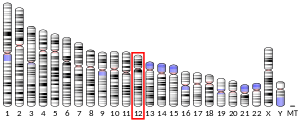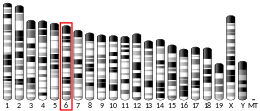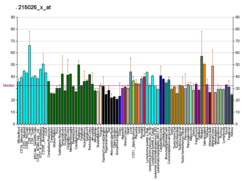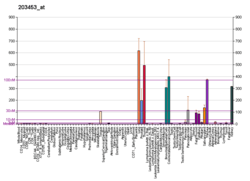SCNN1A
The SCNN1A gene encodes for the α subunit of the epithelial sodium channel ENaC in vertebrates. ENaC is assembled as a heterotrimer composed of three homologous subunits α, β, and γ or δ, β, and γ.[5] The other ENAC subunits are encoded by SCNN1B, SCNN1G, and SCNN1D.
ENaC is expressed in epithelial cells[5] and is different from the voltage-gated sodium channel that is involved in the generation of action potentials in neurons. The abbreviation for the genes encoding for voltage-gated sodium channel starts with three letters: SCN. In contrast to these sodium channels, ENaC is constitutively active and is not voltage-dependent. The second N in the abbreviation (SCNN1A) represents that these are NON-voltage-gated channels.
In most vertebrates, sodium ions are the major determinant of the osmolarity of the extracellular fluid.[6] ENaC allows transfer of sodium ions across the epithelial cell membrane in so-called "tight-epithelia" that have low permeability. The flow of sodium ions across epithelia affects osmolarity of the extracellular fluid. Thus, ENaC plays a central role in the regulation of body fluid and electrolyte homeostasis and consequently affects blood pressure.[7]
As ENaC is strongly inhibited by amiloride, it is also referred to as an "amiloride-sensitive sodium channel".
History
The first mRNA encoding the alpha subunit of ENaC was isolated by two independent groups by screening a rat colon cDNA library.[8][9]
Gene structure
The human gene SCNN1A is located in the short arm of chromosome 12 (12p3).[10] [11] Human SCNN1A includes 13 exons spanning about 29,000 bp. The protein coding region is located in exons 2-13.[11] The positions of introns are conserved in all four human ENaC genes.[12] The positions of the introns are also highly conserved across vertebrates See: Ensembl GeneTree.
Analysis of α subunit mRNA from human lung and kidney showed that during transcription of SCNN1A gene different mRNAs are produced as a result of alternative translation initiation and splicing sites. The isoforms translated from these differ in their activities.[13][14][15][16]

Tissue-specific expression
SCNN1A, SCNN1B, and SCNN1G are commonly expressed in tight epithelia that have low water permeability. The major organs where ENaC is expressed include parts of the kidney tubular epithelia,[5][7][17] the respiratory airway,[18] the female reproductive tract,[18] testis, including, spermatogonia in the seminiferous tubules, Sertoli cells, and spermatozoa,[19] colon and salivary glands.[17] In the skin, SCNN1A is expressed in the keratinocytes in the epidermal layer, in the sebaceous sweat glands, and the smooth muscle cells mostly within the cytoplasm.[20] In contrast, in the eccrine sweat glands ENaC is mostly located on the luminal surface of eccrine duct epithelia.[20]
ENaC is also expressed in the tongue, where it has been shown to be essential for the perception of salt taste.[17]
The expression of ENaC subunit genes is regulated mainly by the mineralocorticoid hormone aldosterone that is activated by the renin-angiotensin system.[21][22] [23]
Protein structure
The primary structures of all four ENaC subunits show strong similarity.[5] Thus, these four proteins represent a family of proteins that share a common ancestor. In global alignment (meaning alignments of sequences along their entire length and not just a partial segment), the human α subunit shares 34% identity with the δ subunit and 26-27% identity with the β and γ subunits.
All four ENaC subunit sequences have two hydrophobic stretches that form two transmembrane segments named as TM1 and TM2.[24] In the membrane-bound form, the TM segments are embedded in the membrane bilayer, the amino- and carboxy-terminal regions are located inside the cell, and the segment between the two TMs remains outside of the cell as the extracellular region of ENaC. This extracellular region includes about 70% of the residues of each subunit. Thus, in the membrane-bound form, the bulk of each subunit is located outside of the cell.
The structure of ENaC has not been yet determined. Yet, the structure of a homologous protein ASIC1 has been resolved.[25][26] The chicken ASIC1 structure revealed that ASIC1 is assembled as a homotrimer of three identical subunits. The authors of the original study suggested that the ASIC1 trimer resembles a hand holding a ball.[25] Hence distinct domains of ASIC1 have been referred to as palm, knuckle, finger, thumb, and β-ball.[25]
Alignment of ENaC subunit sequences with ASIC1 sequence reveals that TM1 and TM2 segments and palm domain are conserved, and the knuckle, finger and thumb domains have insertions in ENaC. Site-directed mutagenesis studies on ENaC subunits provide evidence that many basic features of the ASIC1 structural model apply to ENaC as well.[27][28][29]
Associated diseases
The disease most commonly associated with mutations in SCNN1A is the multi-system form of type I pseudohypoaldosteronism (PHA1B) that was first characterized by A. Hanukoglu as an autosomal recessive disease.[30] This is a syndrome of unresponsiveness to aldosterone in patients that have high serum levels of aldosterone but suffer from symptoms of aldosterone deficiency with a high risk of mortality due to severe salt loss.[5] Initially, this disease was thought to be a result of a mutation in the mineralocorticoid receptor (NR3C2) that binds aldosterone. But homozygosity mapping in 11 affected families revealed that the disease is associated with two loci on chromosome 12p13.1-pter and chromosome 16p12.2-13 that include the genes for SCNN1A and SCNN1B and SCNN1G respectively.[31] Sequencing of the ENaC genes identified mutation in affected patients, and functional expression of the mutated cDNAs further confirmed that identified mutations lead to the loss of activity of ENaC.[32]
In the majority of the patients with multi-system PHA1B a homozygous mutation or two compound heterozygous mutations have been detected.[33][34][35][36]
A stop mutation in the SCNN1A gene has been shown to be associated with female infertility.[37]
Interactions
SCNN1A has been shown to interact with:
See also
Notes
References
- GRCh38: Ensembl release 89: ENSG00000111319 - Ensembl, May 2017
- GRCm38: Ensembl release 89: ENSMUSG00000030340 - Ensembl, May 2017
- "Human PubMed Reference:". National Center for Biotechnology Information, U.S. National Library of Medicine.
- "Mouse PubMed Reference:". National Center for Biotechnology Information, U.S. National Library of Medicine.
- Hanukoglu I, Hanukoglu A (April 2016). "Epithelial sodium channel (ENaC) family: Phylogeny, structure-function, tissue distribution, and associated inherited diseases". Gene. 579 (2): 95–132. doi:10.1016/j.gene.2015.12.061. PMC 4756657. PMID 26772908.
- Bourque CW (July 2008). "Central mechanisms of osmosensation and systemic osmoregulation". Nature Reviews. Neuroscience. 9 (7): 519–31. doi:10.1038/nrn2400. PMID 18509340.
- Rossier BC, Baker ME, Studer RA (January 2015). "Epithelial sodium transport and its control by aldosterone: the story of our internal environment revisited". Physiological Reviews. 95 (1): 297–340. doi:10.1152/physrev.00011.2014. PMID 25540145.
- Lingueglia E, Voilley N, Waldmann R, Lazdunski M, Barbry P (February 1993). "Expression cloning of an epithelial amiloride-sensitive Na+ channel. A new channel type with homologies to Caenorhabditis elegans degenerins". FEBS Letters. 318 (1): 95–9. doi:10.1016/0014-5793(93)81336-x. PMID 8382172.
- Canessa CM, Horisberger JD, Rossier BC (February 1993). "Epithelial sodium channel related to proteins involved in neurodegeneration". Nature. 361 (6411): 467–70. doi:10.1038/361467a0. PMID 8381523.
- Meisler MH, Barrow LL, Canessa CM, Rossier BC (November 1994). "SCNN1, an epithelial cell sodium channel gene in the conserved linkage group on mouse chromosome 6 and human chromosome 12" (PDF). Genomics. 24 (1): 185–6. doi:10.1006/geno.1994.1599. PMID 7896277.
- Ludwig M, Bolkenius U, Wickert L, Marynen P, Bidlingmaier F (May 1998). "Structural organisation of the gene encoding the alpha-subunit of the human amiloride-sensitive epithelial sodium channel". Human Genetics. 102 (5): 576–81. doi:10.1007/s004390050743. PMID 9654208.
- Saxena A, Hanukoglu I, Strautnieks SS, Thompson RJ, Gardiner RM, Hanukoglu A (November 1998). "Gene structure of the human amiloride-sensitive epithelial sodium channel beta subunit". Biochemical and Biophysical Research Communications. 252 (1): 208–13. doi:10.1006/bbrc.1998.9625. PMID 9813171.
- Thomas CP, Auerbach S, Stokes JB, Volk KA (May 1998). "5' heterogeneity in epithelial sodium channel alpha-subunit mRNA leads to distinct NH2-terminal variant proteins". The American Journal of Physiology. 274 (5 Pt 1): C1312–23. doi:10.1152/ajpcell.1998.274.5.C1312. PMID 9612219.
- Chow YH, Wang Y, Plumb J, O'Brodovich H, Hu J (August 1999). "Hormonal regulation and genomic organization of the human amiloride-sensitive epithelial sodium channel alpha subunit gene". Pediatric Research. 46 (2): 208–14. doi:10.1203/00006450-199908000-00014. PMID 10447117.
- Tucker JK, Tamba K, Lee YJ, Shen LL, Warnock DG, Oh Y (April 1998). "Cloning and functional studies of splice variants of the alpha-subunit of the amiloride-sensitive Na+ channel". The American Journal of Physiology. 274 (4 Pt 1): C1081–9. doi:10.1152/ajpcell.1998.274.4.C1081. PMID 9575806.
- Berman JM, Brand C, Awayda MS (2015). "A long isoform of the epithelial sodium channel alpha subunit forms a highly active channel". Channels. 9 (1): 30–43. doi:10.4161/19336950.2014.985478. PMC 4594420. PMID 25517724.
- Duc C, Farman N, Canessa CM, Bonvalet JP, Rossier BC (December 1994). "Cell-specific expression of epithelial sodium channel alpha, beta, and gamma subunits in aldosterone-responsive epithelia from the rat: localization by in situ hybridization and immunocytochemistry". The Journal of Cell Biology. 127 (6 Pt 2): 1907–21. doi:10.1083/jcb.127.6.1907. PMC 2120291. PMID 7806569.
- Enuka Y, Hanukoglu I, Edelheit O, Vaknine H, Hanukoglu A (March 2012). "Epithelial sodium channels (ENaC) are uniformly distributed on motile cilia in the oviduct and the respiratory airways". Histochemistry and Cell Biology. 137 (3): 339–53. doi:10.1007/s00418-011-0904-1. PMID 22207244.
- Sharma S, Hanukoglu A, Hanukoglu I (April 2018). "Localization of epithelial sodium channel (ENaC) and CFTR in the germinal epithelium of the testis, Sertoli cells, and spermatozoa". J. Mol. Histol. 49 (2): 195–208. doi:10.1007/s10735-018-9759-2. PMID 29453757.
- Hanukoglu I, Boggula VR, Vaknine H, Sharma S, Kleyman T, Hanukoglu A (January 2017). "Expression of epithelial sodium channel (ENaC) and CFTR in the human epidermis and epidermal appendages". Histochemistry and Cell Biology. 147 (6): 733–748. doi:10.1007/s00418-016-1535-3. PMID 28130590.
- Mick VE, Itani OA, Loftus RW, Husted RF, Schmidt TJ, Thomas CP (April 2001). "The alpha-subunit of the epithelial sodium channel is an aldosterone-induced transcript in mammalian collecting ducts, and this transcriptional response is mediated via distinct cis-elements in the 5'-flanking region of the gene". Molecular Endocrinology. 15 (4): 575–88. doi:10.1210/me.15.4.575. PMID 11266509.
- Palmer LG, Patel A, Frindt G (February 2012). "Regulation and dysregulation of epithelial Na+ channels". Clinical and Experimental Nephrology. 16 (1): 35–43. doi:10.1007/s10157-011-0496-z. PMID 22038262.
- Thomas W, Harvey BJ (2011). "Mechanisms underlying rapid aldosterone effects in the kidney". Annual Review of Physiology. 73: 335–57. doi:10.1146/annurev-physiol-012110-142222. PMID 20809792.
- Canessa CM, Merillat AM, Rossier BC (December 1994). "Membrane topology of the epithelial sodium channel in intact cells". The American Journal of Physiology. 267 (6 Pt 1): C1682–90. doi:10.1152/ajpcell.1994.267.6.C1682. PMID 7810611.
- Jasti J, Furukawa H, Gonzales EB, Gouaux E (September 2007). "Structure of acid-sensing ion channel 1 at 1.9 A resolution and low pH". Nature. 449 (7160): 316–23. doi:10.1038/nature06163. PMID 17882215.
- Baconguis I, Bohlen CJ, Goehring A, Julius D, Gouaux E (February 2014). "X-ray structure of acid-sensing ion channel 1-snake toxin complex reveals open state of a Na(+)-selective channel". Cell. 156 (4): 717–29. doi:10.1016/j.cell.2014.01.011. PMC 4190031. PMID 24507937.
- Edelheit O, Hanukoglu I, Dascal N, Hanukoglu A (April 2011). "Identification of the roles of conserved charged residues in the extracellular domain of an epithelial sodium channel (ENaC) subunit by alanine mutagenesis". American Journal of Physiology. Renal Physiology. 300 (4): F887–97. doi:10.1152/ajprenal.00648.2010. PMID 21209000.
- Edelheit O, Ben-Shahar R, Dascal N, Hanukoglu A, Hanukoglu I (April 2014). "Conserved charged residues at the surface and interface of epithelial sodium channel subunits--roles in cell surface expression and the sodium self-inhibition response". The FEBS Journal. 281 (8): 2097–111. doi:10.1111/febs.12765. PMID 24571549.
- Hanukoglu I (February 2017). "ASIC and ENaC type sodium channels: conformational states and the structures of the ion selectivity filters". The FEBS Journal. 284 (4): 525–545. doi:10.1111/febs.13840. PMID 27580245.
- Hanukoglu A (November 1991). "Type I pseudohypoaldosteronism includes two clinically and genetically distinct entities with either renal or multiple target organ defects". The Journal of Clinical Endocrinology and Metabolism. 73 (5): 936–44. doi:10.1210/jcem-73-5-936. PMID 1939532.
- Strautnieks SS, Thompson RJ, Hanukoglu A, Dillon MJ, Hanukoglu I, Kuhnle U, Seckl J, Gardiner RM, Chung E (February 1996). "Localisation of pseudohypoaldosteronism genes to chromosome 16p12.2-13.11 and 12p13.1-pter by homozygosity mapping". Human Molecular Genetics. 5 (2): 293–9. doi:10.1093/hmg/5.2.293. PMID 8824886.
- Chang SS, Grunder S, Hanukoglu A, Rösler A, Mathew PM, Hanukoglu I, Schild L, Lu Y, Shimkets RA, Nelson-Williams C, Rossier BC, Lifton RP (March 1996). "Mutations in subunits of the epithelial sodium channel cause salt wasting with hyperkalaemic acidosis, pseudohypoaldosteronism type 1". Nature Genetics. 12 (3): 248–53. doi:10.1038/ng0396-248. PMID 8589714.
- Strautnieks SS, Thompson RJ, Gardiner RM, Chung E (June 1996). "A novel splice-site mutation in the gamma subunit of the epithelial sodium channel gene in three pseudohypoaldosteronism type 1 families". Nature Genetics. 13 (2): 248–50. doi:10.1038/ng0696-248. PMID 8640238.
- Saxena A, Hanukoglu I, Saxena D, Thompson RJ, Gardiner RM, Hanukoglu A (Jul 2002). "Novel mutations responsible for autosomal recessive multisystem pseudohypoaldosteronism and sequence variants in epithelial sodium channel alpha-, beta-, and gamma-subunit genes". Journal of Clinical Endocrinology and Metabolism. 87 (7): 3344–3350. doi:10.1210/jcem.87.7.8674. PMID 12107247.
- Edelheit O, Hanukoglu I, Gizewska M, Kandemir N, Tenenbaum-Rakover Y, Yurdakök M, Zajaczek S, Hanukoglu A (May 2005). "Novel mutations in epithelial sodium channel (ENaC) subunit genes and phenotypic expression of multisystem pseudohypoaldosteronism". Clinical Endocrinology. 62 (5): 547–53. doi:10.1111/j.1365-2265.2005.02255.x. PMID 15853823.
- Zennaro MC, Hubert EL, Fernandes-Rosa FL (March 2012). "Aldosterone resistance: structural and functional considerations and new perspectives". Molecular and Cellular Endocrinology. 350 (2): 206–15. doi:10.1016/j.mce.2011.04.023. PMID 21664233.
- Boggula VR, Hanukoglu I, Sagiv R, Enuka Y, Hanukoglu A (October 2018). "Expression of the epithelial sodium channel (ENaC) in the endometrium - Implications for fertility in a patient with pseudohypoaldosteronism". The Journal of Steroid Biochemistry and Molecular Biology. 183: 137–141. doi:10.1016/j.jsbmb.2018.06.007. PMID 29885352.
- Harvey KF, Dinudom A, Cook DI, Kumar S (March 2001). "The Nedd4-like protein KIAA0439 is a potential regulator of the epithelial sodium channel". The Journal of Biological Chemistry. 276 (11): 8597–601. doi:10.1074/jbc.C000906200. PMID 11244092.
- Malbert-Colas L, Nicolas G, Galand C, Lecomte MC, Dhermy D (July 2003). "Identification of new partners of the epithelial sodium channel alpha subunit". Comptes Rendus Biologies. 326 (7): 615–24. doi:10.1016/s1631-0691(03)00154-9. PMID 14556380.
- Farr TJ, Coddington-Lawson SJ, Snyder PM, McDonald FJ (February 2000). "Human Nedd4 interacts with the human epithelial Na+ channel: WW3 but not WW1 binds to Na+-channel subunits". The Biochemical Journal. 345 Pt 3 (3): 503–9. doi:10.1042/0264-6021:3450503. PMC 1220784. PMID 10642508.
- McDonald FJ, Western AH, McNeil JD, Thomas BC, Olson DR, Snyder PM (September 2002). "Ubiquitin-protein ligase WWP2 binds to and downregulates the epithelial Na(+) channel". American Journal of Physiology. Renal Physiology. 283 (3): F431–6. doi:10.1152/ajprenal.00080.2002. PMID 12167593.
- Boulkroun S, Ruffieux-Daidié D, Vitagliano JJ, Poirot O, Charles RP, Lagnaz D, Firsov D, Kellenberger S, Staub O (October 2008). "Vasopressin-inducible ubiquitin-specific protease 10 increases ENaC cell surface expression by deubiquitylating and stabilizing sorting nexin 3". American Journal of Physiology. Renal Physiology. 295 (4): F889–900. doi:10.1152/ajprenal.00001.2008. PMID 18632802.
- Raikwar NS, Thomas CP (May 2008). "Nedd4-2 isoforms ubiquitinate individual epithelial sodium channel subunits and reduce surface expression and function of the epithelial sodium channel". American Journal of Physiology. Renal Physiology. 294 (5): F1157–65. doi:10.1152/ajprenal.00339.2007. PMC 2424110. PMID 18322022.
Further reading
- McDonald FJ, Snyder PM, McCray PB, Welsh MJ (June 1994). "Cloning, expression, and tissue distribution of a human amiloride-sensitive Na+ channel". The American Journal of Physiology. 266 (6 Pt 1): L728–34. doi:10.1152/ajplung.1994.266.6.L728. PMID 8023962.
- Voilley N, Lingueglia E, Champigny G, Mattéi MG, Waldmann R, Lazdunski M, Barbry P (January 1994). "The lung amiloride-sensitive Na+ channel: biophysical properties, pharmacology, ontogenesis, and molecular cloning". Proceedings of the National Academy of Sciences of the United States of America. 91 (1): 247–51. doi:10.1073/pnas.91.1.247. PMC 42924. PMID 8278374.
- Harvey KF, Dinudom A, Komwatana P, Jolliffe CN, Day ML, Parasivam G, Cook DI, Kumar S (April 1999). "All three WW domains of murine Nedd4 are involved in the regulation of epithelial sodium channels by intracellular Na+". The Journal of Biological Chemistry. 274 (18): 12525–30. doi:10.1074/jbc.274.18.12525. PMID 10212229.
- Arai K, Zachman K, Shibasaki T, Chrousos GP (July 1999). "Polymorphisms of amiloride-sensitive sodium channel subunits in five sporadic cases of pseudohypoaldosteronism: do they have pathologic potential?". The Journal of Clinical Endocrinology and Metabolism. 84 (7): 2434–7. doi:10.1210/jc.84.7.2434. PMID 10404817.
- Saxena S, Quick MW, Tousson A, Oh Y, Warnock DG (July 1999). "Interaction of syntaxins with the amiloride-sensitive epithelial sodium channel". The Journal of Biological Chemistry. 274 (30): 20812–7. doi:10.1074/jbc.274.30.20812. PMID 10409621.
- Schaedel C, Marthinsen L, Kristoffersson AC, Kornfält R, Nilsson KO, Orlenius B, Holmberg L (December 1999). "Lung symptoms in pseudohypoaldosteronism type 1 are associated with deficiency of the alpha-subunit of the epithelial sodium channel". The Journal of Pediatrics. 135 (6): 739–45. doi:10.1016/S0022-3476(99)70094-6. PMID 10586178.
- Snyder PM, Olson DR, McDonald FJ, Bucher DB (July 2001). "Multiple WW domains, but not the C2 domain, are required for inhibition of the epithelial Na+ channel by human Nedd4". The Journal of Biological Chemistry. 276 (30): 28321–6. doi:10.1074/jbc.M011487200. PMID 11359767.
External links
- SCNN1A+protein,+human at the US National Library of Medicine Medical Subject Headings (MeSH)





